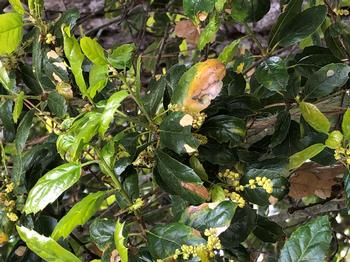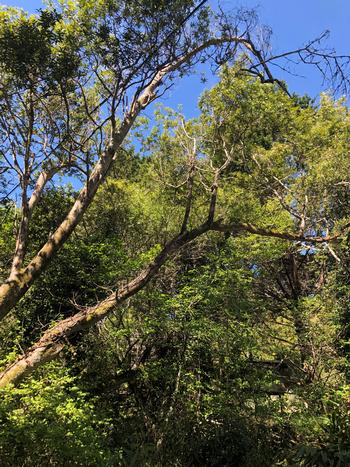Marin’s oak trees
-
Martha Proctor
-
Our mighty oaks need help! With less than 20 inches of rainfall in 2020, Marin County experienced its second driest year, the driest in 90 years. Unfortunately, severe drought conditions have continued in 2021.
During a drought, tree roots are not able to absorb enough moisture as the amount of water available in the soil is greatly reduced. If these conditions continue, the fine hair-like roots whose primary function is to absorb moisture, begin to die back. If the drought persists for a extended period as it has in Marin County, even larger, fibrous roots succumb. Once roots become damaged or lost, it can take days to weeks for trees to re-grow the root hairs necessary to take advantage of rainfall. The stress of losing viable roots increases a tree’s susceptibility to boring beetles, fungi and diseases such as hypoxylon canker. Signs of drought stress are evident in the leaves of this coastal live oak tree. Photo: Martha Proctor
Signs of drought stress are evident in the leaves of this coastal live oak tree. Photo: Martha ProctorSeveral indicators signal that a tree is suffering from drought stress. In short term drought, signs of drought will be most visible in the tree’s foliage. Temporary wilting occurs when the leaves appear wilted & droop one day but recover by the next day. Permanent wilting occurs when the leaves do not recover by the next day. Trees may begin to drop leaves with a brown or burned appearance on the leaf margins or prematurely exhibit the colors of leaves as they age in the fall.
During prolonged droughts, trees develop longitudinal cracks in the bark. Branch death is visible in the top or outer tips of the tree. The canopy will appear sparse with slightly smaller and yellowing leaves. The tree’s growth will slow or seemingly cease. Branch death and sparse canopy signal drought stress in this coastal live oak. Photo: Martha Proctor
Branch death and sparse canopy signal drought stress in this coastal live oak. Photo: Martha ProctorIt’s important to monitor your trees for any symptoms and signs of drought stress. All plants, including trees, need water to photosynthesize, move nutrients from the soil into the tree, enable chemical reactions, trade with their mycorrhizal symbionts, make new leaves, and other functions important for maintaining vitality and health.
Oaks often have deeper and more extensive root systems than many other plants. If you dig a hole and find the soil under your oak 12 to 18 inches down is dry and crumbly, the absorbing roots are totally without access to water. Deep watering of a drought stressed tree is accomplished by moving a soaker hose under the canopy during the day for one or more days at a trickle so that the water percolates into the soil. Start doing this now and repeat through early fall with a month between waterings to allow the soil to dry, reducing the likelihood that fungi will attack the tree roots. The goal is to keep plant roots moist but not wet as constantly saturated conditions damage roots and threaten the tree’s ongoing health.
To help maintain the health of an oak tree during a drought, conserve the existing moisture in the soil by adding mulch under the tree. Although the best mulch is the oak's natural leaf litter, other plant-based mulches can provide a similar benefit. Mulch adds valuable soil micro-organisms, helps control moisture by keeping the soil cool and suppresses weed growth. A good recipe is to top one to two inches of compost with 2 inches of a coarsely chopped mulch. Be careful not to mound the mulch against the root crown as this can promote disease.


